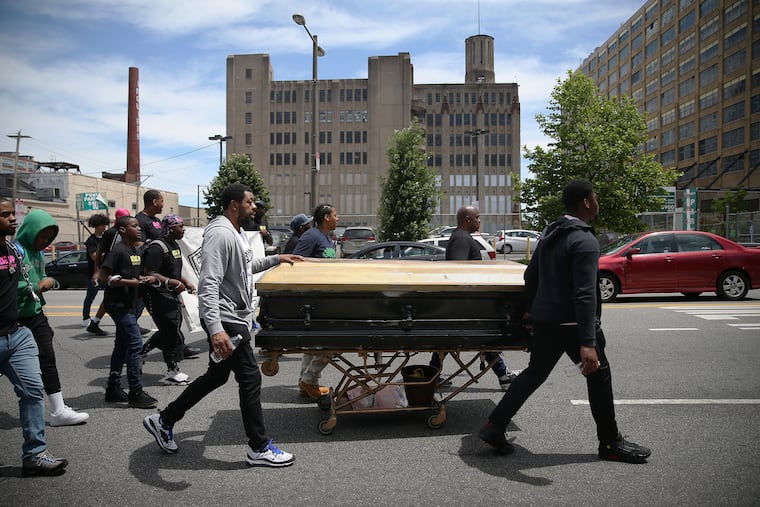Child gun-death rates linked to state gun laws, national study finds
New Jersey, second in the nation for gun law strength, has one of the lowest child and youth homicide rates.

States such as New Jersey, with stricter gun laws, had lower rates of children and teenagers killed by firearms than states with more lenient laws, according to a new national study.
The research, to be published Monday in the journal Pediatrics, found that laws requiring universal background checks for firearm purchases in place for more than five years were associated with a 35 percent lower rate of child and youth deaths.
“Our findings demonstrate a powerful association between the strength of firearm legislation and pediatric firearm-related mortality,” said Monika K. Goyal, lead study author and research director of Children’s National Health System’s emergency medical and trauma division.
The study involved federal data from the Centers for Disease Control and Prevention’s Web-based Injury Statistics Query and Reporting System (WISQRS) from 2011 through 2015. The researchers also used Gun Law Scorecard information from the Brady Campaign to Prevent Gun Violence.
According to the research, 21,241 people ages 21 and under died from firearm-related injuries across the United States in the five-year period studied. That’s an average of 4,250 child and youth deaths each year.
“Firearm injuries represent the second-leading cause of death for U.S. children. That’s about seven funerals a day for kids whose untimely deaths could been prevented,” Goyal said.
Children’s National researchers found measurable decreases in child fatality rates in states with higher scorecard grades for the strictness of their firearm laws as opposed to states with more lax controls.
During the period studied, states were graded on their gun laws’ strictness.
“For every 10-point increase in the strictness of the firearm legislation, there was a 4 percent drop in firearm-related mortality rates among children and youth,” said Goyal.
In 2015, New Jersey had a gun law strength score of 69, the fourth highest in the nation, and a child/youth firearm mortality rate of 2.8 per 100,000. Pennsylvania, at 23, ranked 12th for gun law strictness and had a gun mortality rate of 5.1 per 100,000 children and youths, according to study co-author Gia M. Badolato, Children’s National senior clinical research data manager.
By comparison, Hawaii had the lowest firearm-related mortality rate of 1.1 per 100,000 children, and Alaska was the highest at 18.1 per 100,000.
The national scorecard is now compiled by the Giffords Law Center, and states are assigned letter grades for their firearms-related laws.
In the 2018 ratings, New Jersey was given an A grade and ranked second in the nation, behind California, for the strictness of its gun laws. Pennsylvania got a C+ grade.
Mississippi was deemed to have the weakest gun legislation in the nation, and got an F.
Previous studies have found that states with strict gun laws tended to have lower rates of pediatric suicide, homicide and other firearm-related deaths, the researchers noted.
In fact, new research from Rutgers University-Camden found a significant link between the concentration of federally licensed firearms dealers in urban counties and intimate-partner homicide in the home.
The findings were based on federal data from 16 states, including New Jersey.
“This study showed this robust association regardless of whether the victims were male or female, or how old the victims were,” said Richard Stansfield, one of two assistant professors of criminal justice who authored the study.
The researchers did not find the same association between the presence of federally licensed gun dealers and domestic-partner homicide in rural areas. They theorized that people in rural areas may be more likely to already have a gun in the house and wouldn’t need to buy one if they wanted to harm someone.
“If there is greater access to legal guns, it could make it easier for someone to purchase a gun in the throes of an argument, before there is time to cool off,” said co-author Daniel Semenza. “We can’t definitively say that’s the dynamic here, but this study backs prior research indicating that this great access shows an increased risk.”
The researchers said there needs to be more study on access to legal guns and various types of violence.
The new research, however, has its critics.
A spokesman for the National Rifle Association, however, noted efforts by his organization to reduce the rate of accidental gun deaths amount children and criticised aspects of the Children’s National study.
“No organization in the world has done more to promote the safe and responsible use of firearms than the National Rifle Association,” said NRA spokesman Lars Dalseide. “Thanks to initiatives like NRA’s Eddie Eagle GunSafe Program, the accidental firearm death rate among children has dropped almost 78 percent in the last 20 years.”
Dalseide also accused the researchers of choosing to “cherry pick a microscopic five-year time window of data when there is more than 50 years of data available. Add that to the fact that they did not find causality, they used an arbitrary (at best) metric to measure gun laws, and they included adults in a study about children suggests this study is more propaganda than scientific research.”
The study includes victims age 18 to 21.